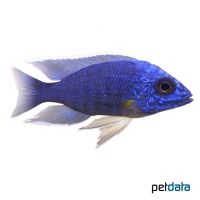Electric Blue Cichlid (Sciaenochromis fryeri)
| Electric Blue Cichlid Sciaenochromis fryeri | |
|---|---|
| Name | Electric Blue Cichlid |
| Name Lat. | Sciaenochromis fryeri |
| Family | Cichlids |
| Family lat. | Cichlidae |
| Order | Cichlids |
| Order lat. | Cichliformes |
| Origin | Lake Malawi |
| Habitat | Intermediate zone |
| Diet | Carnivore |
| pH | 7.5-8.8 |
| Behavior | Semi-aggressive |
| Keeping | Harem |
| Care Level | Moderate |
| Reproduction | Mouthbrooder |
| Breeding | Simple |
| Life Span | 6-10 years |
| Protection | No |
| Metric Units | |
| Size | 12-17 cm |
| Temperature | 24-28 °C |
| Hardness | 10-25 °dH |
| Aquarium | ~ 450 l |
| US Units | |
| Size | 4.7"-6.7" |
| Temperature | 75-82 °F |
| Hardness | 178-445 ppm |
| Aquarium | ~ 120 gal |
Distribution and habitat
The range of the Fryers Malawi Cichlids is exclusively (endemic) to Lake Malawi. They are distributed seaward and live on the rocky coasts in the transition zone of sand and rock, with numerous caves and crevices and sandy bottoms.
Maintenance
The aquarium setup should have rock structures reaching the water surface, with caves and crevices (hiding places) as well as free sand areas and plenty of swimming space. A light-colored, deep substrate of sand or fine gravel is ideal.
No ammonia, ammonium or nitrite should be detectable, and the nitrate value should not exceed 100 mg/l. To ensure the water quality and oxygen content, a filter and heater adapted to the aquarium size is required, as well as lighting for the species-appropriate day-night rhythm of the animals.
Diet
They are ambush hunters that feed on small fish and invertebrates. According to their size, the food offer consists of insect larvae, worms, shrimps and fish, which is accepted without problems also in frozen form, supplemented with commercially available frozen special food mixtures for cichlids. High-quality dry food for cichlids (granules, pellets) is also well accepted
It is recommended to feed small portions several times a day. Regular and varied feeding promotes health and increases resistance. Only as much should be fed as is eaten in a few minutes.
Behaviour and compatibility
They should be kept in a harem, one male with several females. The males are territorial at spawning time, so keeping multiple harems is only recommended in a much larger and richly structured tank. They are assertive hunters, but can be socialized well with other large cichlids. Fish that are too small are considered food
Basically, only compatible fish species with similar demands on water condition and water temperature should be socialized.
Sex dimorphism
The animals differ clearly in coloration (sexual dichromatism). Sexually mature males are bright blue in color, the smaller females are gray-brown. Juveniles are hardly distinguishable.
Reproduction and breeding
They are maternal mouth breeders. The male attracts the mating female into his cave. If no suitable cave is available in the aquarium, the female spawns 50-70 eggs in a shallow pit or a stone. After fertilization by the male, the female immediately takes the eggs into the throat sac for mouthbrooding and keeps the fry in the throat sac even after hatching. After approximately 3 weeks, the fry are released and brood care ends. During the entire mouthbrood care the female does not take any food
Fry must be fed several times a day with special rearing food (Artemia nauplii). In a community tank breeding is hardly possible, because the fry are easy prey.
Important
They are often confused with Ahl's Malawi Cichlids (Scianochromis ahli), which have a slightly different body shape and the males are light blue in color only during breeding season
Azure cichlids from northern Lake Malawi tend to have yellow anal fins, while those from the southern half of the lake tend to have reddish anal fins and often have a white forehead. Azure cichlids are bred in some color variants (color morphs).
The well-being of the fish should be monitored regularly. Temperature should be checked daily, pH, hardness and nitrate levels at least every 14 days. Regular partial water changes are recommended, even when contaminant levels have not yet reached the upper limit. Sudden changes in water quality should be avoided. Newly introduced fish must be accustomed slowly to the water in the aquarium.
Further literature can be found in your pet store.
References
Text: Werner Winter; Image: petdata
Source: BMEL (1998): Tierschutzgutachten - Haltung von Zierfischen (Süßwasser); RIEHL & BAENSCH (2006): Aquarien Atlas Bd. 5, Mergus Verlag; ENGELMANN (2005): Zootierhaltung - Tiere in menschlicher Obhut: Fische, Verlag Harri Deutsch
- Gemäß § 21 Abs. 5 Tierschutzgesetz idgF
